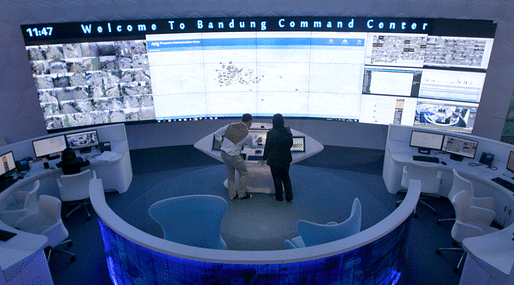
Singapore City, SG
Smart Cities 2.0 explores some of the world’s most iconic Smart Cities for inaugural Channel NewsAsia series
Eco-architect Jason Pomeroy goes beyond technology, to uncover how cities leverage culture and tradition to make them smarter and more liveable
SINGAPORE, February 22, 2017 – Eco-architect Jason Pomeroy, will be hosting an exciting new TV series for Channel NewsAsia, called Smart Cities 2.0. The weekly 8-part TV series will explore some of the world’s most reknown smart cities, and how they combine technology, culture, history and tradition to make them smarter and more efficient. Smart Cities 2.0 extends over eight episodes, and includes Songdo, South Korea; Bandung, Indonesia; Shenzhen, China; Ahmedabad, India; Barcelona, Spain; Higashimatsushima, Japan; Amsterdam, The Netherlands and Singapore. It will air on Channel NewsAsia from March 4, 2017.
‘For many people, the term ‘Smart City’ conjures up images of driverless cars whizzing through the streets, Big Data acting as Big Brother, the Internet of Things or talking fridges’ says host Jason Pomeroy, adding ‘it is a utopian (or dystopian) future largely driven and influenced by technology. But what we uncover in Smart Cities 2.0 is that a truly smart city will not just utilise technology and the Internet of Things (IoT), but will foster community and promote culture as well – thus enhancing the quality of people lives. By 2050, we will have added a further 3 billion people living on this planet, many of whom will live in urban areas. So we will need smarter ways to build and plan our cities so that they become centres of growth and innovation, without destroying the natural environment’.
The diversity of the cities covered in Smart Cities 2.0 is deliberate, and allows Pomeroy to both reinforce and debunk many of the current perceptions that surround Smart Cities. Barcelona, for example, does not strike many as a typical Smart City, but the ancient metropolis is filled with sensors and technology that makes city life smoother, while retaining its cultural heritage. Bandung in Indonesia leverages people-power and social media to get smarter; Amsterdam relies on the power of data analytics to become more efficient, while Higashimatsushima’s Smart City quest, born in tragedy, will allow it to become truly self-sufficient.
Given the role cities have in contributing to, and combating, Climate Change, the need for cities to better serve their citizens efficiently and sustainably has never been higher. Yet the definitions of ‘Smart City’ are as different as the cities themselves, and it is too often associated solely with technology. Smart Cities 2.0 aims to highlight the diversity of the world’s Smart Cities, uncovering how each city has its own reasons for becoming smarter, and what constitutes ‘smart’ in one metropolis, may not be the same as another.
As well as delving into the cities themselves, Pomeroy interviews personalities who have had a role in shaping their respective cities, including architects, city planners and academics. The cities covered include:
Jason Pomeroy hosted and consulted for Smart Cities 2.0. He is the Founding Principal of the Singapore-based sustainable design firm, Pomeroy Studio, and is widely regarded as being at the forefront of the sustainable built environment agenda. He has worked on pioneering projects throughout Asia and has designed the region’s first carbon-zero landed property, Digital Hub at BSD City in Jakarta – coined the silicon valley of Indonesia, and an upcoming iconic technology hub in Mediapolis, Singapore. In all his projects, he balances the use of green technologies with elements of local culture and tradition as a means of improving the sustainability and liveability of the cities, buildings and landscapes he creates.
Smart Cities 2.0 teaser is available to view Here.

Smart Cities 2.0 is produced by Very! (www.very.sg) and premieres on Saturday March 4, 2017 at 8:30 PM on Channel NewsAsia, via the following channels:
REGIONAL (26 countries)
-- END --
About Jason Pomeroy
Prof. Jason Pomeroy is an award-winning architect, academic, author and TV personality at the forefront of the sustainable built environment agenda. He gained his Undergraduate and Postgraduate degrees from the Canterbury School of Architecture, a Masters degree from the University of Cambridge, and a PhD from the University of Westminster. Prof. Pomeroy is the author of ‘Pod Off Grid: Explorations in Low Energy Waterborne Communities’ (2016), ‘The Skycourt and Skygarden: Greening the Urban Habitat’ (2014) and ‘Idea House: Future Tropical Living Today’ (2011). He holds professorship at the University of Nottingham (UK), Universita IUAV di Venezia (Italy) and James Cook University (Australia). Jason also works to raise awareness of the cultural role architecture plays in society through his award-winning television series on Channel NewsAsia – ‘City Time Traveller’ (Series 1 & 2) and ‘City Redesign’. www.jasonpomeroy.sg
About Pomeroy Studio
Pomeroy Studio is an award-winning international team of designers and thought leaders of sustainable built environments. The studio comprises of master planners, landscape architects, architects, interior and graphic designers, as well as sustainability consultants and academics. Quantitative and qualitative research complements an interdisciplinary design process that lies at the foundation of their creative design and decision-making. This has allowed the studio to generate people-centred places, from the micro-scale of dwellings to the macro-scale of cities, that pushes the envelope of design and research by balancing a ‘creative vigour with an academic rigour’.
For more information, please contact:
Chloe Li by phone +65 6592 6827 or email: pr@pomeroystudio.sg
No Comments
Block this user
Are you sure you want to block this user and hide all related comments throughout the site?
Archinect
This is your first comment on Archinect. Your comment will be visible once approved.